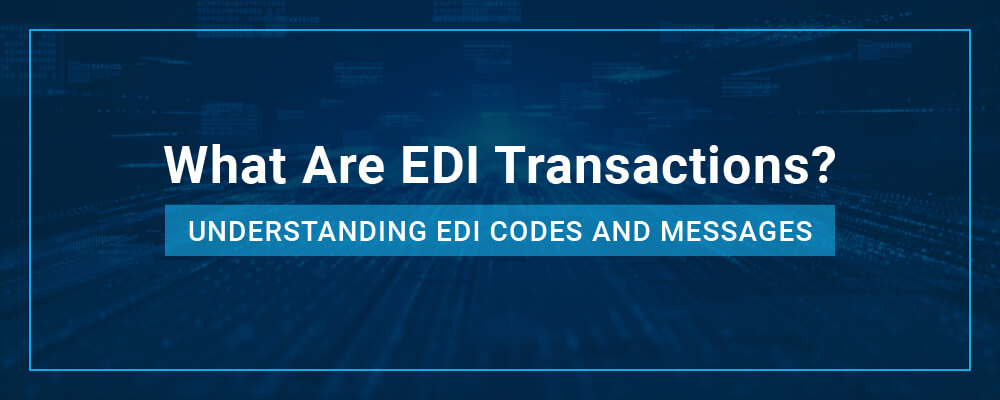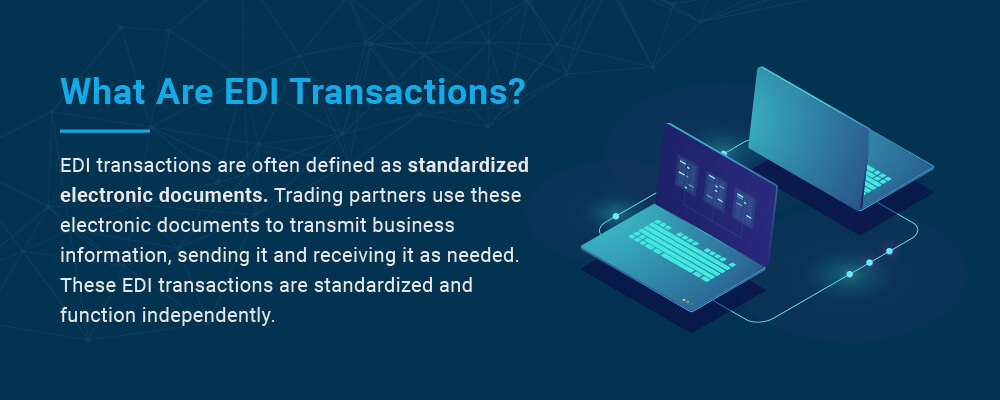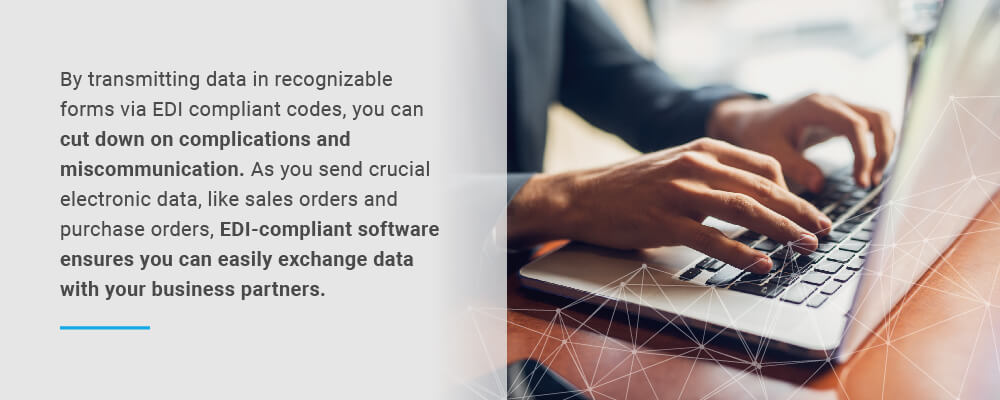
EDI stands for Electronic Data Interchange and refers to an exchange of data between two parties via computers. EDI transactions and codes are essential for many businesses, as EDI allows them to exchange business documents with their clients quickly. EDI codes create communication standards and promote seamless transfers of information. Compliance with EDI codes is crucial for businesses that rely on EDI for transactions, such as those in the transportation and logistics industry and the retail and manufacturing industry.
This guide covers the importance of EDI compliance, how EDI transactions work and common EDI transaction codes.
What Are EDI Transactions?
EDI transactions are often defined as standardized electronic documents that trading partners use to transmit business information. These transactions can include various types of documents such as purchase orders, invoices, shipping notices, and payment confirmations. By utilizing EDI transactions, businesses can ensure efficient and accurate communication. These EDI transactions are standardized and function independently. EDI codes refer to specific EDI transactions to help companies locate the appropriate documents they should use.

Segments of an EDI Transaction
Your EDI transaction sets will feature multiple segments. These segments refer to groups of data elements logically connected to one another. Rather than have a single segment, EDI documents feature different sections defined by individual segments. For example, a purchase order will have the price, units, quantity and item number in different segments. A segment starts with its segment ID, which designates the kind of data elements in the segment.
Segments also feature separators between the various data elements. EDI standards make some segments mandatory, but companies can also include optional segments in their documents. Since segment types must follow specific standards, companies can easily follow the rules for proper segment use in an EDI transaction.
Why Is EDI Compliance Important?
When a business uses EDI, it should be well aware of EDI standards. These standards help set a uniform way of communication between businesses and clients. While companies will have different protocols based on the needs of their business, EDI standards account for companies' different requirements, crafting EDI transaction documents and codes for varying situations.
Without standards for EDI, companies could have different codes and protocols on a case-by-case basis. This lack of standards could make it so clients and companies have different commands and codes they're familiar with, leading to inefficient data exchange. By transmitting data in recognizable forms via EDI compliant codes, you can cut down on complications and miscommunication. As you send crucial electronic data, like sales orders and purchase orders, EDI-compliant software ensures you can easily exchange data with your business partners.

Benefits of EDI Compliance
EDI compliance comes with many benefits to companies that use EDI transaction codes and documents. By following EDI standards, organizations can see operational and financial advantages due to increased efficiency and accuracy. Additionally, companies can receive greater client and trading partner benefits, helping them retain clients and form better business relationships.
1. Operational Advantages
When a company uses EDI, it can automate many key processes and see more efficient operations. These operational benefits allow businesses to serve their customers and trading partners better, helping them form better relationships. EDI compliance is key to improving business relationships, as it ensures accuracy and efficiency across operations.
By switching to electronic documents following EDI standards, companies can significantly reduce paper-based operations. Many businesses know how much of a headache paper-based operations can be, as they open the door for human errors. EDI transaction sets safeguard against errors in key functions like payment processing, returns processing and data tracking. EDI removes the need to enter data manually and keeps accurate records of any transmitted data.
When a company engages in order fulfillment, EDI gives staff a more detailed look at their inventory and supply chain. This greater visibility allows the company to process orders much faster. Additionally, EDI's ability to keep accurate information about orders helps companies better review their inventory, supply chain and orders and make more informed decisions. This increased data can help businesses adjust to new market conditions faster and stay ahead of their competitors.
2. Financial Advantages
EDI compliance also offers several financial benefits to companies that properly use EDI transactions. With EDI, companies can reduce their reliance on paper-based systems, helping to save material costs. Additionally, the move away from paper systems also cuts down on costs related to major factors like long wait times and expensive errors.
Without EDI to transfer information automatically, companies have to pay for envelopes, postage, paper, ink and transit costs. When you're sending out key information, these costs can add up significantly. You may also see indirect costs in the form of fuel and labor in the shipping process, as well as increased maintenance and administrative expenses. These administrative costs largely come down to the need to purchase storage boxes and pay employees to prepare, file and retrieve paper documents. An EDI system removes these costs and saves you money by sending information electronically and often automatically.
Switching to EDI also helps reduce many labor costs in your business related to the handling of data. Companies that make their employees perform manual tasks like entering data and copying, filing, sorting and reviewing documents have to spend a significant amount of money on labor. EDI can automate many of these tasks, reducing labor costs. Automating processes also saves you money since you reduce the chances of human error causing a costly mistake.
3. Client and Trading Partner Advantages
In addition to providing operational and financial benefits, EDI compliance can also improve a company's relationship with its clients, suppliers and other business partners. For example, EDI allows companies to respond to market changes more quickly, minimizing order disruptions and streamlining operations. The lowered response time means companies can quickly relay changing information to trading partners and keep them in the loop. A company's fast response can also keep client or customer satisfaction high, changing their services or products to meet a consumer's evolving needs.
EDI also makes it easier for companies to communicate regularly with their business partners. With EDI, companies can easily provide information about processes and tasks, such as purchase orders, pending payment statuses, shipping statuses and invoices. EDI compliance allows companies to send information quickly and accurately to their trading partners, helping both parties meet each other's expectations.
Besides strengthening trading partner relationships, companies can also use EDI to meet customer expectations and retain their loyalty over time. As mentioned previously, companies can respond faster to market changes and consumer expectations. Additionally, EDI supplies companies with greater data accuracy and information on orders, which helps them improve customer service.
Common EDI Transaction Codes
You can find thousands of EDI codes, but there are a few common codes you might want to know. EDI codes refer to various EDI transaction documents and protocols, helping companies communicate with one another easily. Companies in many industries use EDI, but the transportation and logistics industry and the retail and manufacturing industry, in particular, both regularly employ these common EDI transactions to complete jobs and transfer information.
Here are some of the most common EDI transaction codes for these two industries:
- EDI 204 Motor Carrier Load Tender: Companies use this transaction code to request a shipment's movement. Once a full truckload carrier receives the request, they can see relevant information, such as costs and shipment requirements, and make an informed decision as a result.
- EDI 210 Motor Carrier Freight Details and Invoice: Instead of using paper invoices, freight carriers use EDI 210 to invoice relevant shippers for delivering goods.
- EDI 214 Transportation Carrier Shipment Status Message: Transportation carriers use EDI 214 to give consignees and shippers extensive information about their shipment's status. Trucking companies use this code widely to help relevant parties stay up to date about shipments at any time.
- EDI 753 Routing Instructions Request: To better serve clients, suppliers can use this code to request a client's routing instructions.
- EDI 754 Routing Instructions: When a purchaser wants to tell their supply partners information about sending shipments, often in response to EDI 753, they use EDI 754. This code allows purchasers to provide details about the time and place of shipments.
- EDI 810 Invoice: Once a company receives an EDI 850 Purchase Order, they send back an EDI 810 Invoice. These electronic invoices request payment for any services or products a company provided to a client.
- EDI 812 Credit/Debit Adjustment: When a billback or a price adjustment happens, a company can send a notification via an EDI 812 to suppliers, merchants, retailers, vendors or wholesalers. Companies that experience regular price fluctuations often use this code.
- EDI 820 Payment Order/Remittance Advice: Companies use an EDI 820 to transmit remittance data and begin payments. Many suppliers use these EDI transaction codes to check if invoices have been paid in full and track those that still require payments. After a company receives an EDI 810 Invoice, they send an EDI 820 to a supplier.
- EDI 830 Planning Schedule with Release Capability: Manufacturers usually use this code to transfer material release or forecasting information to suppliers. The code lets sellers properly allocate resources, like material and labor, and automatically complete orders based on a customer or client's inventory information.
- EDI 832 Price/Sales Catalog: The EDI 832 is a document made for electronically transferring pricing and product information. This detailed data comes in a catalog form.
- EDI 844 Product Transfer Account Adjustment: Companies use an EDI 844 to transmit credit or debit data. They also employ it to make a request for credit relating to a product's pre-authorized transfer actions.
- EDI 846 Inventory Inquiry/Advice: Suppliers use an EDI 846 to let purchasers know about their inventory levels, such as information about future orders and current goods stocked. The 846 can refer to a specific warehouse or the supplier's general stock.
- EDI 849 Response to Product Transfer Account Adjustment: Most often, manufacturers use an EDI 849 to communicate with resellers, like distributors and wholesalers, to dispute rebate and chargeback information or to confirm their acceptance. This code is always used to respond to an EDI 844.
- EDI 850 Purchase Order: The U.S. retail industry relies on the EDI 850 Purchase Order as a standard document for purchasing services, goods and merchandise. Vendors and suppliers use this code to ensure accuracy in their purchasing orders.
- EDI 852 Product Activity Report: Trading partners use EDI 852 as a standardized format to transmit information related to current inventory and product levels. They also use it to communicate information about point-of-sale product sales rates.
- EDI 855 Purchase Order Acknowledgment: After a vendor or supplier receives a purchased order from a distributor, retailer or customer, they'll send back an EDI 855. The supplier or vendor uses this code to confirm receipt of an order. The code can also include information about the seller's rejection or acceptance of an order, as well as requests for an order modification.
- EDI 856 Advance Ship Notice: Companies use EDI 856s to notify relevant parties about an awaiting delivery, much like a packing list. This code is mainly designed to provide more data about packing and tracking.
- EDI 864 Text Message: This transaction set sends information in a human-readable format rather than one geared for computer processing. Companies often use EDI 864s to send messages and contracts.
- EDI 880 Grocery Products Invoice: A grocery supplier uses an EDI 880 to communicate with a buyer about billing details and ask for payment based on goods purchased.
- EDI 940 Warehouse Shipping Order: Sellers, usually wholesalers or manufacturers, use an EDI 940 to send instructions about shipping orders to remote warehouses. Companies will authorize warehouses to send a shipment to buyers via this code. Sometimes, sellers also use an EDI 940 to cancel past shipper orders, modify shipments or confirm shipments.
- EDI 945 Warehouse Shipping Advice: The EDI 945 helps companies confirm shipments. Warehouses typically use this code to notify their trading partners about when they ship relevant products.
To achieve EDI compliance, businesses must ensure their systems align with the required standards and protocols, regularly review their EDI processes, and maintain open communication with trading partners.
Learn More About How ConnectPointz Can Automate EDI Transaction Exchanges
With all of the benefits of EDI transaction exchanges and the many EDI transaction sets and codes you can use in your business, you might be interested in partnering with a company that can help you implement EDI in your operations. ConnectPointz can process all types of EDI codes, and we're ready to help you implement EDI solutions and reach 100% EDI compliance. We regularly help retailers, transporters and manufacturers become EDI capable, helping them implement shipping and logistics solutions.
Learn more about we can help your company automate EDI transaction exchanges by contacting us today. If you're ready to see what we can do for you, complete our registration process.










































